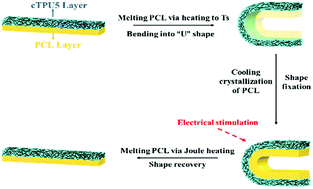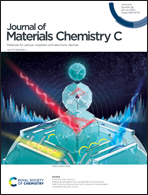Controllable distribution of conductive particles in polymer blends via a bilayer structure design: a strategy to fabricate shape-memory composites with tunable electro-responsive properties†
Abstract
Electro-responsive shape-memory composites (ESMCs) are a type of advanced smart materials, which are of significant interest in the self-driven device field. In this study, a series of thermoplastic polyurethane/polycaprolactone/multi-walled carbon nanotube (TPU/PCL/MWCNT) bilayer ESMCs were fabricated via the hot lamination of MWCNT-filled TPU and pure PCL, pure TPU and MWCNT-filled PCL, and MWCNT-filled TPU and MWCNT-filled PCL, while maintaining the overall amount of MWCNTs at ∼2.5 wt%. By tuning the assembly method, a controllable distribution of MWCNTs in the TPU layer as the memorizing phase and a PCL layer as the switching component was easily realized. As compared to the conventional blending composite (CBC) that contains the same compositions, the bilayers showed a much larger electrical conductivity because the confined layer space promoted filler connection, especially when MWCNTs were dispersed in PCL. In addition, the bilayers composed of continuous TPU could provide a stronger driving force when activated by an electric field, showing a better shape recoverability than that of CBC. With the manipulation of applied voltage and MWCNT distribution, the bilayer composites could achieve an excellent shape recovery ratio above 97.0% below 20 V. Specifically, the specimen with a confined distribution of MWCNTs in PCL was able to finish almost an entire self-deployment at an extremely low voltage of 5 V. This work develops a new strategy to fabricate ESMCs with tunable performances, which is expected to be applicable to other combinations of shape-memory systems and conductive particles. The materials presented herein have promising application prospects in sensors, actuators, aerospace devices, and so forth.



 Please wait while we load your content...
Please wait while we load your content...